As a designer, you’ve probably sent countless files off for manufacturing, but have you ever stopped to think about what "plastic moulding" truly means? It’s a term we use every day, yet its full meaning can feel a bit vague. This uncertainty can make it hard to communicate effectively with manufacturers or to fully grasp the potential and limitations of the process for your designs. Let’s define it clearly, once and for all.
Plastic moulding is a manufacturing process where a pliable raw material, like plastic pellets, is shaped using a rigid frame called a mold or die. The plastic is typically heated until it’s liquid or soft, then forced into the mold’s cavity. After it cools and hardens into the shape of the cavity, the finished part is removed. This method is the foundation for mass-producing an incredible variety of plastic items, from simple bottle caps to complex automotive dashboards.
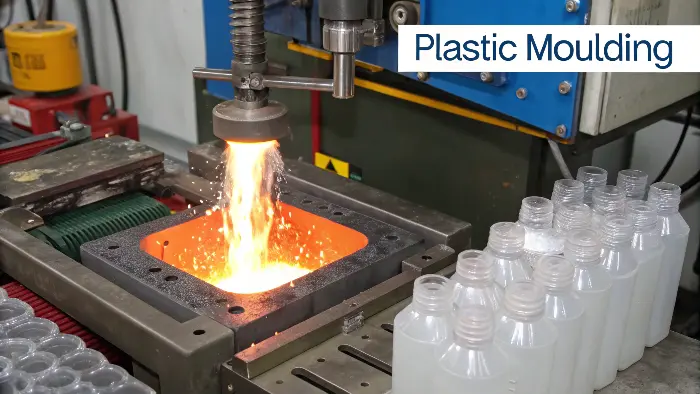
I’ve built my career on this very process, and I believe that a deep understanding of its core meaning is the first step toward mastering it. It’s not just about making parts; it’s about transforming a raw material into a functional, valuable product with precision and repeatability. We’re going to break down what moulding really is, look at the different ways it’s done, and even explore the human side of the industry. Let’s get started.
What is the meaning of plastic moulding?
You know the basic definition, but what does "plastic moulding" really encompass? It’s more than just a single action; it’s a whole category of industrial art. Thinking of it too narrowly can limit your creativity and problem-solving as a designer. I want to expand on this definition to give you a more complete picture of this powerful technology.
The true meaning of plastic moulding lies in its core principle: using a negative space (the mold) to give a positive form to a polymer. It represents a scalable, repeatable method for converting raw plastic resin into a finished or semi-finished product with specific properties and high fidelity to the original design. It’s a blend of material science, mechanical engineering, and thermal dynamics, all working together to create consistent parts efficiently.
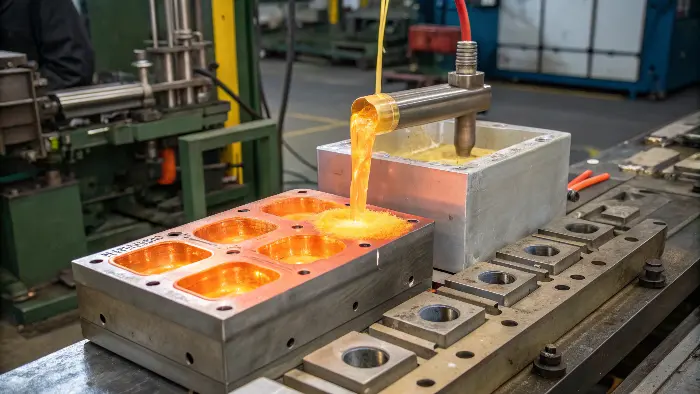
To truly grasp the meaning, we need to look beyond the simple definition and understand the materials and principles at play. When I work with designers like Jacky, I always emphasize that the material choice is just as important as the process itself. The "plastic" in plastic moulding is not one single thing.
Thermoplastics vs. Thermosets
The world of mouldable plastics is primarily divided into two families. Understanding this distinction is fundamental.
| Feature | Thermoplastics | Thermosets |
|---|---|---|
| Reaction to Heat | Soften when heated, harden when cooled. | Undergo a chemical change when heated (curing) and become permanently hard. |
| Reversibility | Can be remelted and reshaped multiple times (recyclable). | Cannot be remelted. The change is irreversible. |
| Molecular Structure | Long chains with weak intermolecular bonds. | Cross-linked, rigid 3D network structure. |
| Common Examples | Polypropylene (PP), ABS, Polycarbonate (PC), Nylon | Epoxy, Phenolic, Silicone, Polyurethane |
I remember a project early in my career where a client specified a material that couldn’t handle the part’s operating temperature. We switched from a standard thermoplastic to a high-performance thermoset, which solved the problem. Knowing this difference saved the project.
The Core Concept: Replication
At its heart, moulding is about replication. The mold is the master template. Every part that comes out of it is a near-perfect copy. This is why so much effort and cost goes into creating the mold itself. The mold is an investment in consistency. Its precision, surface finish, and cooling system design are all transferred to every single part it produces. So, the meaning of plastic moulding is really the meaning of high-fidelity, high-volume replication.
How is plastic moulding done?
Knowing the principle is one thing, but how does it actually happen on the factory floor? The process can seem like a black box: raw pellets go in one end, and finished parts come out the other. This lack of visibility can be frustrating when you’re trying to design a part that is easy and cost-effective to manufacture. Let’s open up that black box.
Plastic moulding is typically done through a four-stage cycle. First, the two halves of the mold are clamped together with immense force. Second, molten plastic is injected under high pressure into the mold’s cavity. Third, the plastic is allowed to cool and solidify, which is often the longest part of the cycle. Finally, the mold opens, and the solid part is ejected. This highly automated cycle repeats to produce thousands or millions of identical parts.
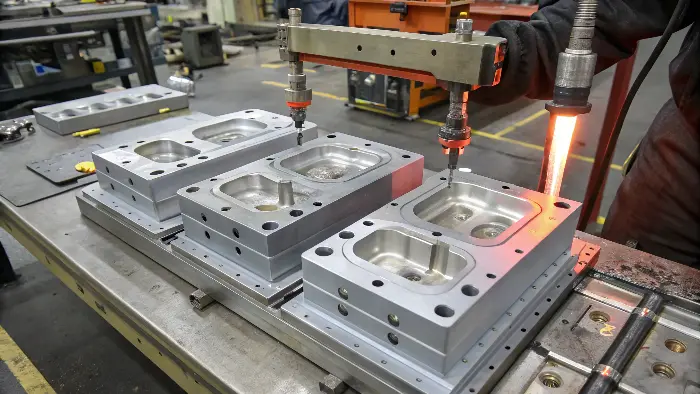
I’ve watched this cycle millions of times, and its rhythm is the heartbeat of any plastics factory. Optimizing this cycle is how we ensure quality and control costs. Let’s break down each of those four steps in a bit more detail.
Step 1: Clamping
Before anything else can happen, the mold must be securely closed. The injection moulding machine uses a powerful hydraulic or electric system to press the two halves of the mold together. This clamping force is massive, measured in tons, and it’s essential to counteract the even greater pressure of the injection phase. If the clamp isn’t strong enough, molten plastic can escape between the mold halves, creating a defect called "flash."
Step 2: Injection
This is the action phase. A large screw inside a heated barrel melts plastic pellets and then acts like a plunger, forcing the molten plastic forward at high speed and pressure. The plastic travels through a nozzle, into the mold’s runner system, through a gate, and finally fills the cavity. The speed, pressure, and temperature must be controlled with extreme precision to ensure the cavity fills completely without defects.
Step 3: Cooling
Once the cavity is filled, the part needs to solidify. This happens as the heat from the plastic transfers to the relatively cool metal of the mold. The mold has internal channels with circulating water or oil to manage this temperature and speed up the process. The cooling phase is critical; it determines the final dimensions, strength, and surface finish of the part. It’s also usually the longest stage, so efficient cooling design is key to a profitable cycle time.
Step 4: Ejection
After the part is solid, the clamping unit opens the mold. A set of pins, sleeves, or plates built into the mold then pushes forward to eject the finished part, which falls into a collection bin or onto a conveyor belt. The mold then closes again, and the entire cycle restarts, sometimes in just a few seconds.
What are the types of plastic moulding?
Now that you understand the basic process, you might think all plastic moulding is the same. But that’s like saying all cars are the same. Different part shapes and materials require different techniques. Using the wrong process for your product can lead to poor quality or unnecessarily high costs. Let’s explore the diverse family of moulding methods available.
While injection moulding is the most common, there are many other types of plastic moulding. Key methods include blow moulding for hollow items like bottles, rotational moulding for large, hollow products like tanks, compression moulding for strong, flat parts, and extrusion for continuous shapes like pipes or window frames. Each type is designed to efficiently produce a specific kind of geometry or work with a particular material.
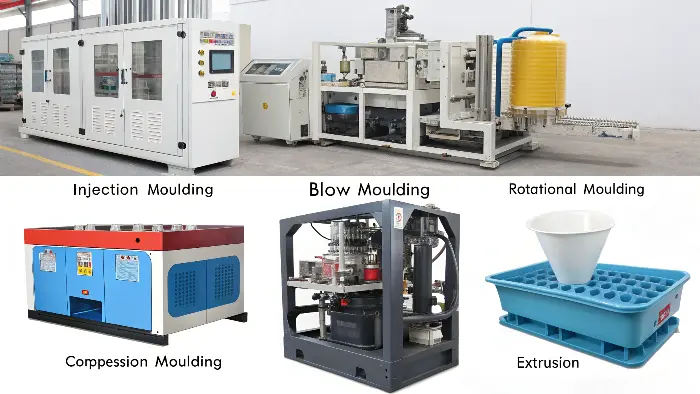
Choosing the right process is one of the most important decisions you’ll make with your manufacturing partner. I always guide my clients through this choice early in the design phase. Here’s a quick comparison of some of the most important types.
A Comparison of Moulding Processes
| Moulding Type | How it Works | Typical Products | Key Advantage |
|---|---|---|---|
| Injection Moulding | Molten plastic is injected into a closed mold cavity under high pressure. | Lego bricks, phone cases, car interior parts, electronic housings. | High precision, complex details, fast cycle times for high volume. |
| Blow Moulding | A hollow tube of plastic (parison) is inflated with air inside a mold. | Bottles, jugs, hollow containers, fuel tanks. | Excellent for producing hollow parts quickly and cheaply. |
| Rotational Moulding | Plastic powder is heated in a slowly rotating mold, coating the inside walls. | Large tanks, kayaks, playground slides, coolers. | Creates very large, seamless, stress-free hollow parts with uniform wall thickness. |
| Compression Moulding | A pre-measured amount of plastic (a "charge") is placed in a heated mold, which is then closed, forcing the material to fill the cavity. | Electrical outlets, gaskets, automotive parts (often with thermosets). | Great for high-strength parts, especially with fiber-reinforced thermoset materials. |
| Extrusion | Molten plastic is continuously pushed through a die to create a long, continuous profile. | Pipes, tubing, window frames, weather stripping, plastic film. | Produces continuous lengths of a constant cross-section very efficiently. |
Each of these methods has its own unique strengths. For a complex, solid part with fine details, injection moulding is the king. But if you’re designing a 500-gallon water tank, rotational moulding is the only practical choice. Understanding this landscape of options is key to innovative and efficient product design.
What is the job description of plastic molding?
We’ve talked a lot about processes and machines, but who are the people that make it all happen? A factory isn’t just a collection of equipment; it’s a team of skilled individuals. Understanding their roles can help you, as a designer, communicate better and appreciate the expertise involved in bringing your vision to life. So, what does a "job in plastic moulding" actually look like?
The job description for plastic moulding isn’t one single role but a collection of specialized positions. Key roles include the Mold Designer who creates the tool, the Process Technician who sets up and fine-tunes the machine parameters, the Machine Operator who oversees production, and the Quality Inspector who ensures parts meet specifications. It’s a collaborative effort requiring a mix of engineering knowledge, hands-on skill, and attention to detail.
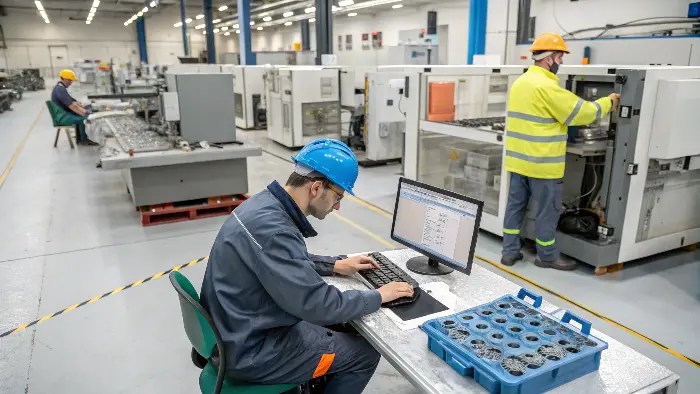
When I started my own company, I had to wear many of these hats myself. It gave me a huge appreciation for the skill each role requires. Let’s break down the key players on the factory floor.
The Core Roles in a Moulding Operation
- Mold Designer: This is a highly skilled engineer, often like our friend Jacky, who uses CAD software to design the complex steel mold. They must consider everything from how the plastic will flow to how the part will cool and eject. Their work is the blueprint for the final product.
- Toolmaker: This is the artisan who takes the designer’s blueprint and physically creates the mold. They are masters of CNC machining, EDM, grinding, and polishing. They build, maintain, and repair the most critical piece of equipment in the whole process.
- Process Technician (or Setter): This is the expert who installs the mold into the machine and dials in all the settings—temperature, pressure, speed, and time. They are the troubleshooters. When a part has a defect, they are the ones who diagnose the problem and adjust the process to fix it. I consider a good process tech to be worth their weight in gold.
- Machine Operator: This person is responsible for the day-to-day running of one or more machines. They handle material loading, starting and stopping the machine, and performing initial visual checks on the parts as they are produced.
- Quality Inspector: This individual is responsible for verifying that the parts meet all the client’s specifications. They use tools like calipers, micrometers, and CMMs (Coordinate Measuring Machines) to check dimensions and perform tests to ensure the part is strong and functions correctly.
These roles all work together in a symphony of production. A great design from a designer is only as good as the toolmaker who builds the mold and the technician who runs it.
Conclusion
In the end, plastic moulding is a powerful and versatile technology that turns raw plastic into the countless products that shape our world. It’s a process defined by its principle of replication, executed through a precise cycle of clamping, injecting, cooling, and ejecting. With a variety of methods and a team of skilled professionals behind it, moulding offers a solution for nearly any plastic part you can imagine. I hope this gives you a clearer, more complete understanding.
